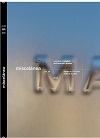The Multidirectionality of Memory: Networks of Trauma in Post-9/11 Literature
DOI:
https://doi.org/10.26754/ojs_misc/mj.20148777Abstract
9/11 fictional literature shows a striking propensity to conjure up other, historically older traumata and intertextual references in an associative framework which moreover introduces into the texts an oscillation between narrative representation and indexical reference, and which I will exemplify in a reading of J.S. Foer’s Extremely Loud & Incredibly Close and Art Spiegelman’s In the Shadow of No Towers. Based on an understanding of trauma as a structure of reception rather than a phenomenon essentially linked to specific events, trauma in my approach emerges not only as an interpretational framework for dealing with the aesthetics and psychology of post-9/11 fiction, but also as an intercultural and diachronic link which fictional literature experiments with. Working with the model of multidirectional collective memory developed by Michael Rothberg, this specific quality of intertextuality and intergenerational dialogue gives rise to the impression that the memorialization of the terrorist attacks on September 11th, 2001, functions in a more dynamic way than it at first glance appears to do. In this contemporary context, literary trauma therefore emerges not primarily as an un-representable void, but must rather be described in terms of a productive, albeit liminal in-between space of both individual and cultural remembering and aesthetic representation.
Display downloads
References
ADORNO, Theodor W. 1969. Kulturkritik und Gesellschaft. Frankfurt am Main: Suhrkamp.
ASSMAN, Aleida. 2006. Erinnerunsräume. München: C.H. Beck.
BARTHES, Roland. 1980. La Chambre Claire. Note sur la Photographie. Paris: Gallimard.
BENJAMIN, Walter. (1936) 1999. “The Storyteller. Reflections on the Works of Nikolai Leskov”. In Arendt, Hannah. (ed.) Illuminations. London: Pimlico: 83-110.
BORRADORI, Giovanna. 2003. Philosophy in a Time of Terror. Dialogues with Jürgen Habermas and Jacques Derrida. Chicago: University of Chicago Press.
CARUTH, Cathy. (ed.). 1995. Trauma. Explorations in Memory. Baltimore: Johns Hopkins U.P.
CARUTH, Cathy. 1996. Unclaimed Experience. Trauma, Narrative and History. Baltimore: Johns Hopkins U.P.
—. 2002. “An interview with Jean Laplanche”. In Belau, Linda (ed.). Topologies of Trauma. Essays on the Limit of Knowledge and Memory. New York: Other Press: 101-126.
CVEK, Sven. 2011. Towering Figures. Reading the 9/11 Archive. Amsterdam/New York: Rodopi.
DAVIS, Walter A. 2006. Death’s Dream Kingdom. The American Psyche since 9-11. London: Pluto Press.
FOER, Jonathan Safran. (2005) 2006. Extremely Loud & Incredibly Close. London: Penguin.
FREUD, Sigmund. (1939) 1970. Der Mann Moses und die monotheistische Religion. Frankfurt am Main: Suhrkamp.
—. (1892) 1966. “Zur Theorie des Hysterischen Anfalls”. In Freud, Anna. (ed.). Sigmund Freud. Gesammelte Werke. Band XVII: Schriften aus dem Nachlass. Frankfurt am Main: S. Fischer Verlag: 9-13.
HOROWITZ, Mardi. (ed.). 1999. Essential Papers on Posttraumatic Stress Disorder. New York/London: New York U.P.
KÜHNER, Angela. 2003. Kollektive Traumata. Konzepte, Argumente, Perspektiven. Berlin: Berghof-Forschungszentrum für Konstruktive Konfliktbearbeitung.
LACAPRA, Dominick. 2001. Writing History, Writing Trauma. Baltimore: Johns Hopkins U.P.
LAUB, Dori. 2002. “September 11, 2001 —An Event without a Voice”. Trauma Research Net Newsletter 2. <http://www.traumaresearch.net/net2/forum2/laub.htm>. Accessed June 5, 2013.
LYOTARD, Jean-Francois. (1988) 2005. Heidegger und “die Juden”. Ed. Engelmann, P. Trad. C-C. Härle. Wien: Passagen-Verlag.
PEIRCE, Charles S. (1895) 1998. Of Reasoning in General. Ed. N. Houser. “The Essential Peirce”, Vol. 2 (1893-1913). Bloomington and Indianapolis: Indiana U.P.
RAPAPORT, Herman. 2002. “Representation, History, and Trauma: Abstract Art after 1945”. In Belau, L and P. Ramadanovic (ed.). Topologies of Trauma. Essays on the Limit of Knowledge and Memory. New York: Other Press.: 233-250.
REDFIELD, Marc. 2009. The Rhetoric of Terror. Reflections on 9/11 and the War on Terror. New York: Fordham U.P.
RICOEUR, Paul. 1986. The Rule of Metaphor. Multi-Disciplinary Studies of the Creation of Meaning in Language. London: Routledge.
ROTHBERG, Michael. 2009. Multidirectional Memory. Remembering the Holocaust in the Age of Decolonization. Standford, California: Standford U.P.
SAAL, Ilka. 2011. “Regarding the Pain of Self and Other: Trauma Transfer and Narrative Framing in Jonathan Safran Foer’s Extremely Loud & Incredibly Close”. Modern Fiction Studies vol. 57-3: 453-476.
SEBALD, W.G. 2003. On the Natural History of Destruction. New York: Random House.
SPIEGELMAN, Art. 2004. In The Shadow of No Towers. New York: Pantheon.
VERSLUYS, Kristiaan. 2009. Out of the Blue. September 11 and the Novel. New York: Columbia Press.
WHITEHEAD, Anne. 2004. Trauma Fiction. Edinburgh: Edinburgh U.P.
Downloads
Published
Issue
Section
License
Copyright (c) 2014 Katharina Donn

This work is licensed under a Creative Commons Attribution-NonCommercial 4.0 International License.


